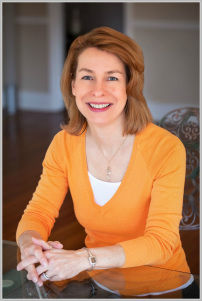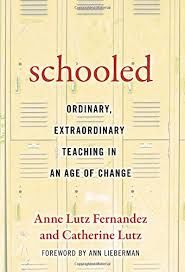Decision-making coalitions are in full swing creating plans for the reopening schools this fall. If you listen to the constituents of school communities, you'll likely learn that almost everyone—children, parents, school staff—is eager to return. But only if it's safe to do so.
The teachers I've spoken with recently feel that many of their concerns are underrepresented in these discussions. I've written extensively on health, education, and parenting, and I've asked noted educator Anne Lutz Fernandez to join me in a conversation about the issues.

Anne is a high school teacher who has taught for two decades in public schools. She's a former businessperson with a B.A. in Political Science from Brown University and a Masters in Teaching English from Boston College. And along with anthropologist Catherine Lutz, Anne is the author of Schooled: Ordinary, Extraordinary Teaching in an Age of Change.
Here's our recent discussion:
Lynne: Like most issues these days, politicians have managed to turn the reopening of schools during the coronavirus pandemic into a partisan issue. As a teacher and expert on education, what’s at stake for children, parents, and teachers when we talk about fully reopening? Operating a hybrid learning model? Keeping physical schools closed?
Anne: Teachers often find themselves at the center of contentious policy debates, including life and death ones, like gun violence, and the pandemic isn’t different in that sense. Full reopenings are the ideal from an academic, equity, and economic standpoint—of course, that’s all predicated on them being safe. And though full reopenings would bring more structure back to children’s lives, safety measures will make school feel anything but normal, and we don’t know how safe children will feel in buildings.
Hybrid plans seek to provide more structure and more effective instruction while allowing for safer buildings because they’ll be less crowded. These are bound, though, to cause logistical issues for working parents and teachers. Finally, we saw the possibilities and limitations of remote learning this spring; some students didn’t access education at all this way. If we reopen schools, however, but have to close them because of outbreaks, we’ll be back to remote learning anyway; some argue if we devoted funding and planning exclusively to it, we could bring remote learning closer to the ideal—without risking lives.
There are those who claim that teachers are arguing for one or another option out of self-interest, rather than the interests of their students. The reality is that teachers’ working conditions are students’ learning conditions. We need to listen to teachers, some of the most mission-driven and research-driven professionals out there, and the people who know firsthand what goes on in classrooms, when we ask what is best for kids. And we can’t let politicians blame teachers if schools don’t open. If schools don’t open, it’s because the government failed to contain the virus when other countries have.
Lynne: What messages are teachers getting when our society implies that they have a responsibility to be in the classroom like doctors need to be in hospitals?
Anne: On the one hand, the comparison highlights that teachers are highly educated professionals whose work is essential to a healthy and functioning society. On the other, the rationale for this has centered on the need for teachers to be back in classrooms so that parents can go back to work. This plays into the notion of the teacher as primarily a babysitter and can make teachers feel disposable. Many teachers are rightly alarmed that some politicians are urging swift, full school reopenings when infection rates are high in so many states; they don’t want to be forced back into buildings unsafely so that parents can be forced back to their workplaces unsafely.
Lynne: Anyone following the news knows that the scientific way to slow the spread of the virus is to test, test, test. In the absence of a robust surveillance system and funds to put in place new distancing and cleaning practices, is it even appropriate to be discussing putting teachers and school staff, children, and families at risk?
Anne: We should be discussing every option for students to learn. The problem right now is an administration that, just as with the economy, is presenting school reopenings as an either/or proposition. Children must go immediately and full-time back into school buildings, or they will suffer tremendous damage! This binary is a dangerous fallacy.
In the absence of a national testing and tracing program, states and districts have had to explore ways to educate children as safely as possible. Encompassing so many unknowns, this is already a complex and treacherous task, but without the additional funds from Congress and with the political pressure coming from the White House, I worry that decisions are being made that ignore science or otherwise cut corners in ways that put lives at greater risk.
Lynne: This pandemic has highlighted how difficult it is for parents to care for their young children while also being effective employees. How can teachers support parents’ reality of needing to supervise their child’s education more closely?
Anne: Being thrust suddenly into remote learning this spring was a challenge for teachers, students, and parents. One big issue is the variation from district to district in terms of the resources making it more or less effective, especially for parents who can’t work from home or families that lack internet access. Parents whose children have special needs had the most difficult time, as teachers struggled to provide them [with] services.
This summer, districts worked to plan for the possibility of a return to remote learning or hybrid learning, and a few keys emerged: prioritizing children with special needs, more frequent feedback to students and communication between teachers and parents, and better support structures for teachers and parents from the administration. As a teacher, flexibility is critical. Teachers are paring down the curriculum to essentials and adapting it to make it easier to access. The debates about synchronous or live teaching and asynchronous teaching touch on this; many parents prefer live teaching, but for others, their ability to access and supervise lessons requires the flexibility provided by asynchronous lessons.
Lynne: It's true that distance learning has exacerbated existing inequalities in our education system, primarily access to technology. What ways might school districts address this should the safe choice for all be to keep physical schools closed?
Anne: I keep coming back to the responsibility of Congress to provide the additional emergency funding to provide this needed technology and infrastructure now. They failed to pass anything in the spring when districts were scrambling—doing things like parking WiFi hot-spot buses in some neighborhoods in the morning and in others in the afternoon—and when it could have led to better, more equitable education this fall, but it is not too late for them to act.
It’s hard not to fantasize about tech billionaires stepping up and doing something dramatic right now, but I’m wary of hidden costs and attached strings from crisis-moment private sector help. Going forward, we need to address the structural issues that create these inequalities in our education system, including school funding reform and segregation. Before the pandemic, teachers were already being asked to solve many of the problems society should rightly solve, but that it has failed to. Poverty, weak infrastructure, income inequality: These issues are larger than schools.
Lynne: What do you say to those people, including educators and parents, who think children should go back to school because they are at the lowest risk? How do you think teachers feel when they are left out of this consideration?
Anne: I worry first of all about what we don’t know about the risk to children; research is limited, and though the fatality rate has been low, we can’t know about potential long-term effects on children who’ve recovered from the virus. We’ve seen successful school openings, but only in countries where the virus has been contained.
In recent weeks, as the virus curve in the U.S. has shot up higher than ever, teachers have brought their concerns about their own health forward. One in four teachers, the Kaiser Family Foundation tells us, are at high risk from the virus. That’s nearly 1.5 million teachers! Many teachers are, of course, parents, so those not personally at higher risk of death from contracting the virus still worry about bringing the infection home to their families.
Despite enduring years of lockdowns and shooter drills, teachers did not sign up to die at work. And we already know adult-to-adult transmission is a serious possibility. Indoor settings? Poor ventilation? The worst conditions for spreading the virus sound just like most schools. In Arizona, summer school teachers were recently infected with the coronavirus despite teaching students remotely, and despite mask-wearing and social-distancing, because they were working together in a classroom in a state with rising infection rates. One has died.
Having seen my students devastated by the sudden death of a beloved colleague, I dread the effect on children of the death from COVID-19 of one or more of the adults in their school. How would children process the grief, fear, and guilt of thinking that a beloved teacher or other staff member died after likely being infected at school? It’s not accurate to say kids are safe from the virus.
Lynne: Proponents of reopening schools at all costs often cite that it’s imperative to do so because children require socialization to thrive. But isn’t it true that interactions with adults, siblings, and other extended family members provide children with healthy socialization? Aren’t there other supports that could be considered for children with unique vulnerabilities regarding socialization? Behavior? Or other learning challenges?

Anne: In Schooled, I profiled a homeschooling parent alongside school teachers, given that more than 2.3 million children were taught at home pre-pandemic. Although a lack of socialization is a traditional argument against homeschooling, I learned that home-schooled children have many relationships and activities outside the home in addition to the socialization they receive within it. Still, particularly with children already spending many hours in front of screens, the social skills children develop in schools is critical.
If we can’t be in schools for some period because it is not physically safe, we need to help parents find safe, innovative, and free ways to provide socially distanced activities in small groups and outdoors. When I say “we” here, I mean all of us in the community, not just educators and parents of school-age children. “Open streets” programs are one option for safe socializing and healthy exercise, where some streets are closed to traffic and devoted to outdoor dining, cycling, and structured activities for kids, like socially distanced scavenger hunts and other games. It’s time for all hands in.
References
You can follow Anne Lutz Fernandez on Twitter @lutzfernandez.




